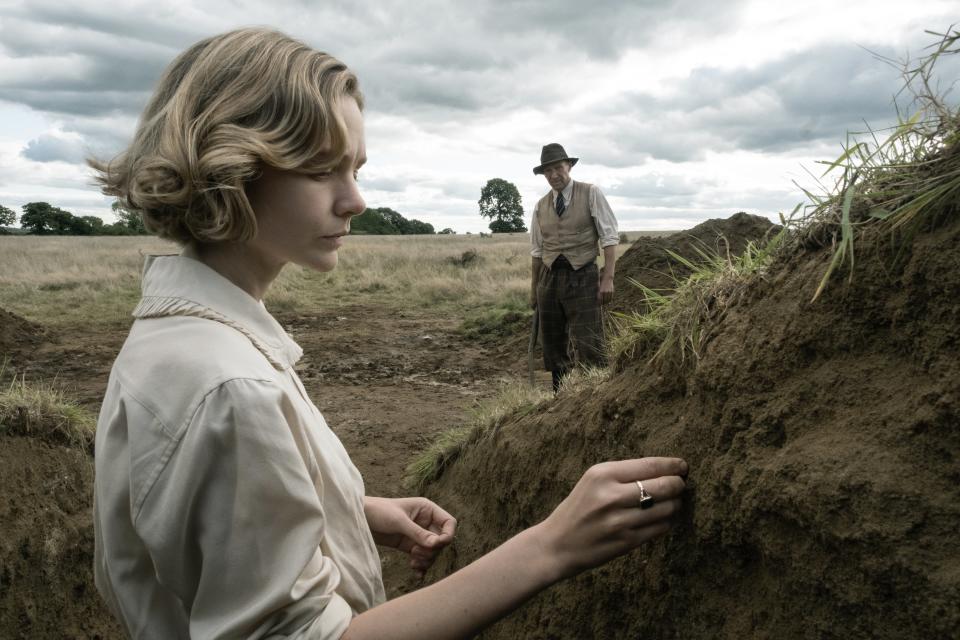The Dig review: An incredible cast and a compelling real life story lend Netflix’s period piece some depth

A wistfully cosy Netflix drama, set in 1939, Simon Stone’s film takes liberties with the true life story of “invisible” archaeologist, Basil Brown, but gets away with it thanks to an incredible cast (Carey Mulligan, Ralph Fiennes, Johnny Flynn, Lily James) and the strength of the source material.
Mulligan is well-heeled, ailing widow, Mrs Edith Pretty, who has a feeling that one in particular of the curious “mounds” on her vast Suffolk estate may contain treasures. At first, Brown (Fiennes), the working class, self-styled “excavator” she hires to do some exploring, disagrees. But after being almost buried alive in the earth, he has a revelation and sets to work.
Edith’s hunch proves correct. Brown unearths a ship, full of a sixth-century chieftain’s prized possessions, which delights Pretty’s precocious son, Robert (Archie Barnes; uncannily sweet). It seems for a moment as if the connection between Pretty and Brown will lead to romance. Instead, the focus shifts to tensions between Brown and the pompous Charles Phillips (Ken Stott), brought in by the Office of Public Works to oversee the dig. The latter wants to keep Brown away from the burial chamber. Will this horrible snob sideline our working class hero? And what will happen to Peggy, (James), the archeologist who finds the first piece of gold?
Wait. What? Who cares about Peggy? The answer, perhaps, lies in the fact that The Dig is based on a book by Peggy’s nephew, John Preston. She was in fact a pioneer of modern settlement studies (better known by her later name of Margaret Guido) but her storyline doesn't reflect that. Will the pretty, patronised Peggy stick by her reticent husband (Ben Chaplin), or let herself fall for Edith’s (fictional) dashing cousin, Rory (Flynn)? If you don’t give a toss, you’ll find the film’s second half extremely aggravating.

As already mentioned, this story hangs only loosely on the facts. In 1939, the real Brown was 51 (Fiennes is 58). Edith was 56 (unlike Mulligan, who is 35). We need more stories about middle-aged women, not fewer. It’s bad news that a part based on a fiftysomething mould-breaker (which would have been perfect, say, for Emily Watson, Anne-Marie Duff, Helena Bonham Carter or Shirley Henderson) has been given to a performer in her thirties. It’s said that women become invisible when they reach 50. A film like The Dig is part of the problem.
That said, Mulligan is so wondrously good at conveying loneliness/longing/intellectual frustration/maternal terror that casting her as Edith could hardly be called a mistake.

As for Fiennes, ever since his gloriously perverse turn in The Grand Budapest Hotel, he’s had a twinkle in his eye that undercuts complacency. Basil is, in many ways, a cliché. He’s as dependable and decent as The Fast Show’s Ted. But Fiennes makes us feel as if it’s OK to laugh. In other words, he provides the intelligence that Moira Buffini’s script itself often lacks.
Like the soon to be released Ammonite, The Dig is about a scientist from the wrong side of the track, who faces prejudice at every turn. Stone’s film never gets its hands dirty in the way that Francis Lee’s does. But it’s a whole lot rougher, and wryer, than Downton Abbey.
If The Dig could have been deeper, it’s hardly a shallow grave.
On Netflix from January 29. 112 mins, 12

 Yahoo Movies
Yahoo Movies 
